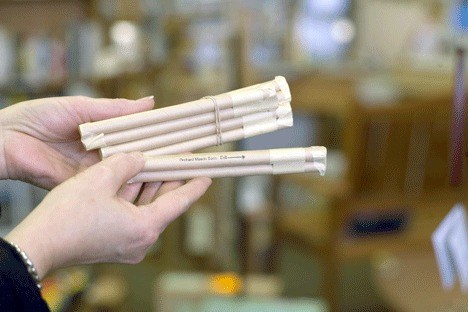It’s no secret the honey bees’ numbers are declining.
But the mason bee?
It’s alive and well. And native, unlike the better-known honey bee.
Lydia Sikes, who owns Whidbey Wild Bird with her husband Phil, said now is the time to start thinking about garden pollination. If Whidbey growers can’t rely on honey bees, which have been hit in recent years by a colony collapse disorder, they can start their own hive of mason bees.
“It’s a great project for kids,” she said of the friendly, non-aggressive bee. “They don’t care about you at all.”
And unlike the honey bee, masons are native to the Northwest.
“They make a very happy garden and fruit trees,” Sikes said.
The insects are available in sets of three refrigerated tubes. Each tube contains about seven bees, Sikes said.
Keep the bees cool until the outdoor temperature warms up to at least 50 degrees on a regular basis, then place the tubes outside in a sheltered area next to a nesting box or post with drilled, 5/16th-inch holes. As the temperature increases, the bees will hatch from the tubes and do what they do best: pollinate.
First-time beekeepers may want to purchase a Pieris Japonica, one of the the mason bee’s favorite flowers, to ensure there’s plenty of food available for their new garden helpers.
The bees will return to the nesting box and lay their eggs, each separated by a small mud wall, which is how the small bumbling insect earned the name “mason bee.”
Sikes cautions novice beekeepers to place their nesting boxes in a covered area away from birds.
The mason bee season runs from now until June. By then the bees will be done with their duty. Surrounding fruit trees will be pollinated and their eggs will be laid. Each egg is laid in its own mud-packed cell with a pollent-nectar mix. The end of June is a good time to move the hive into a cooler in the garage or in the refrigerator, until next season. The larvae will hatch, eat the pollen mixture, spin cocoons, go through metamorphosis and hibernate until the next season.
If the hive is left unprotected between seasons, birds and wasps will pilfer the eggs, Sikes said.
In one season, a colony of 21 bees can multiply to 140. After two seasons, the same colony can reach almost 1,000 members.
Remember to add more nesting boxes or drill more holes to accommodate the colony expansion each year, Sikes said. Whidbey Wild Bird is located at 860 SE Pioneer Way 101. Call 279-2572 for more information.



